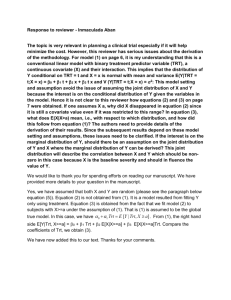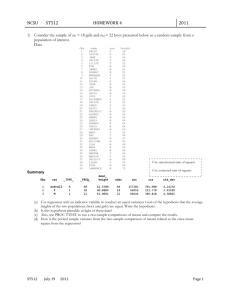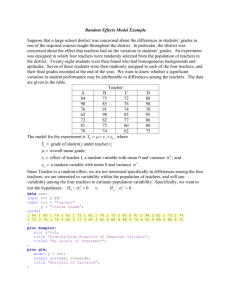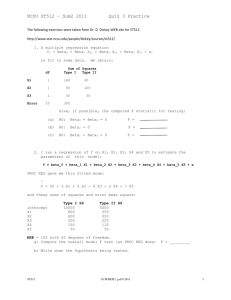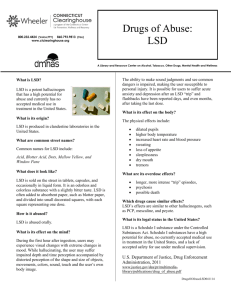Mean Separation Output
advertisement
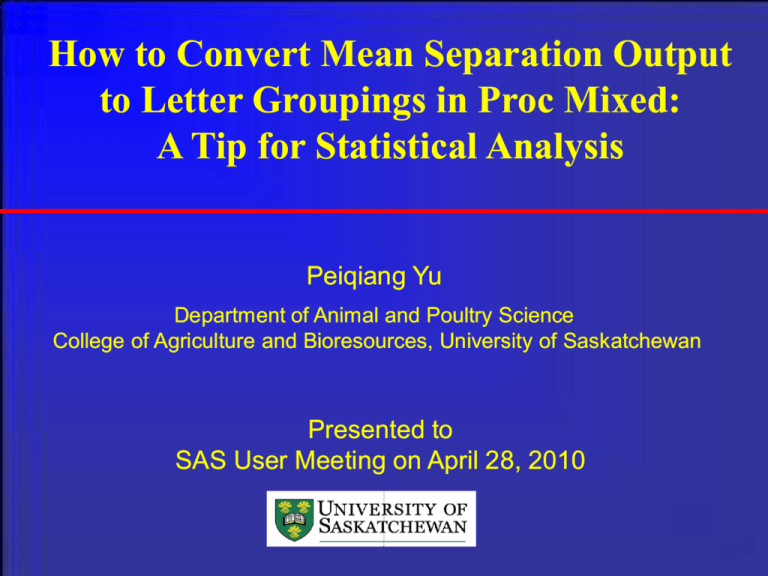
How to Convert Mean Separation Output to Letter Groupings in Proc Mixed: A Tip for Statistical Analysis Peiqiang Yu Department of Animal and Poultry Science College of Agriculture and Bioresources, University of Saskatchewan Presented to SAS User Meeting on April 28, 2010
SAS User Meeting on April 28, 2010 Background • Before Proc Glimmix is released in Version 9.2, we use Proc Mixed 9.2, we use Proc Mixed for statistical Proc Mixed for statistical analysis for mixed effect models analysis for mixed effect models • Such as RCBD, LSD, Split Such as RCBD, LSD, Split­ ­plot, Repeated plot, Repeated Measures… • What is a Mixed effect model? What is a Mixed effect model?
Mixed Effect Model? Model: To describe data from a given treatment and design structures, we usually write a model as follow: Model: Y = { trt structure components} + { Y = {trt structure components} + {design structure components} + { design structure components} + {error structure} components} + { error structure}. . Mixed Effect Model: (There are two types of mixed models) (1) If some of the factors in the model are fixed effects and some are (1) If some of the factors in the model are random effects, or (2) If there is more than one variance more than one variance or covariance component (in the model used to characterize the variability
in the model used to characterize the variability )
Background • Using Using Proc GLM Proc GLM (OLS) to analyse data (OLS) to analyse data from a Mixed Effect Model from a Mixed Effect Model is inaccurate. Mixed Effect Model is inaccurate. • Some Journals won’t accept analysis by Proc GLM, for example, Repeated Measures… we need to use Proc Mixed
Measures… we need to use Proc Mixed Background • However, using Proc Mixed for multi­ However, using Proc Mixed for multi ­treatment treatment comparison does not produce a nice output. • It dose not assign letters to TRT means. • We need to assign letters for each TRT by hand. • If you have too many TRTs, how to do by hand?? If you have too many TRTs, how to do by hand??
Background • However, there is a program: called “pdmix800.SAS “ pdmix800.SAS” ” • We can use SAS software + Pdmix800.sas to assign letters for TRTs when we do multi­ multi ­trt comparison. trt comparison. • Use an example to show you how…. Use an example to show you how….
Example Mixed Model Analysis of Latin Square Designs (LSD)
Latin Square Designs (LSD) An example­ LSD design I. 1. What is LSD design ? Ø This experiment was setup to investigate the effects of This experiment was setup to investigate the effects of 4 dietary treatment (starch levels) (T1 to T4) on milk production (Y dependent variable= milk yield). 4 x 4 LSD Period 1 Period 2 Period 3 Period 4 Cow 1 T1 (192) T2 (190) T3 (214) T4 (221) Cow 2 T2 (195) T4 (203) T1 (139) T3 (152) Cow 3 T3 (292) T1 (218) T4 (245) T2 (204) Cow 4 T4 (249) T3 (210) T2 (163) T1 (134)
Department of Animal and Poultry Science University of Saskatchewan II. 3. How to Use Mixed Model to Analyze LSD II. Procedures to Analyze LSD using Mixed Model Step 1. Modeling the variance­covariance structures [CS, AR(1), ANTE etc ] is a covariance structures [CS, AR(1), ANTE etc ] is a first (or preliminary) step in the analysis of repeated measures (LSD) data step in the analysis of repeated measures (LSD) data using mixed model methodology. (The first task is to obtain a better model for the variance­covariance (The first task is to obtain a better model for the variance structure of the repeated measures on the same subject, eg. cow) Step 2. Compare AIC and BIC fit statistical analysis to find the best covariance Compare AIC and BIC fit statistical analysis to find the best covariance model (AIC =Akaike information criterion; BIC =Bayesian information criterion) (The smaller AIC and BIC number, the better fit of covariance model, so AIC and BIC number, the check AIC and BIC number). Step 3. Using the best fit variance­covariance structure model to analyse your covariance structure model to analyse your data and then do multi­trt comparisons. trt comparisons. (We are not interested in the covariance structure (in its own right). (We are not interested in the covariance structure Instead, we are interested in obtaining a good model obtaining a good model for the covariance structure so that comparisons and s and inference about fixed effect are
valid). Department of Animal and Poultry Science University of Saskatchewan II. 3. How to Use Mixed Model to Analyze LSD II. Example (LSD): The following Program: Mixed Model Code for LSD Analysis Step 1. Modeling the variance­covariance structures is a first covariance structures is a first (or preliminary) step in the analysis of repeated measures (eg. LSD) data using mixed model methodology. When we use a mixed model to analyze LSD, we need to test and select the most appropriate variance­covariance assumption structures, such as covariance assumption structures, such as ·
·
CS (compound symmetry)
AR(1) (first order autoregressive), Here we test CS and AR(1) variance ­ ­covariance assumption structure:
Department of Animal and Poultry Science University of Saskatchewan
Department of Animal and Poultry Science University of Saskatchewan II. 3. How to Use Mixed Model to Analyze LSD II. Example (LSD): The following Program: Mixed Model Code for LSD Analysis options nocenter pageno=1; data one; input per trt $ cow yield; cards; Data step 1 T1 1 192 1 T2 2 195 1 T3 3 292 1 T4 4 249 2 T2 1 190 2 T4 2 203 2 T1 3 218 2 T3 4 210 3 T3 1 214 3 T1 2 139 3 T4 3 245 3 T2 4 163 4 T4 1 221 4 T3 2 152 4 T2 3 204 4 T1 4 134 Department of Animal and Poultry Science University of Saskatchewan
Department of Animal and Poultry Science University of Saskatchewan ; Example: Mixed Model Code for LSD Analysis II. 3. How to Use Mixed Model to Analyze LSD II. The first program code: test Compound Symmetry (CS Compound Symmetry (CS) assumption for variance­ covariance structure: Program step title1 'Using Mixed model for LSD analysis: a specified repeated measure analysis' 'Using Mixed model for LSD analysis: a specified repeated measure analysis'; title2 'Test 1: CS=compound symmetry assumption' 'Test 1: CS=compound symmetry assumption'; proc mixed data=one covtest =one covtest cl; class per trt cow; model yield = per trt / ddfm=kenwardroger; =kenwardroger; repeated per /subject = cow = cow type =cs r rcorr; run; Test CS
Department of Animal and Poultry Science University of Saskatchewan Variance and Covariance Assumption Structures Variance and Covariance Assumption Structures: II. Analysis of LSD Design using Mixed model 1 st variance and covariance assumption structure: Compound Symmetric Assumption Structure (CS) Compound Symmetric Assumption Structure (CS): § Equal variances (σ 2 + σ 1 ) on the main diagonal; § Equal covariance (σ 1 ) on all off­diagonals ) on all off § Equal correlation (ρ). Table 2. The variance and covariance matrix obtained by fitting the CS structure Table 2. The variance and covariance matrix obtained by fitting the for the example data Time 1 (Period 1) 2 (Period 2) 3 (Period 3) 4 (Period 4) 2 1 σ +σ1 (=928.8) 2 σ1 (=793.62) σ 2 +σ1 3 σ1 σ1 σ 2 +σ1 4 σ1 σ1 σ1 σ 2 +σ1
Department of Animal and Poultry Science University of Saskatchewan II. 3. How to Use Mixed Model to Analyze LSD II. The following is the 2nd program code : Test First Order Autoregressive ­ The following is the 2nd program code
AR(1)­ assumption for variance­covariance structure to see whether it is better to covariance structure to see whether it is better to fit model. Program step title1 'Using Mixed model for LSD analysis: a specified repeated measure analysis' 'Using Mixed model for LSD analysis: a specified repeated measure analysis'; title2 'Test 2: AR(1)= First order autoregressive assumption' 'Test 2: AR(1)= First order autoregressive assumption'; proc mixed data=one covtest =one covtest cl; class per trt cow; model yield = per trt /ddfm ddfm=kenwardroger; repeated per/subject = cow type type =AR(1) r rcorr; run; Test AR(1)
Department of Animal and Poultry Science University of Saskatchewan 2 nd Variance and covariance structure: “AR(1) ­ First Order Autoregressive Assumption Structure”: First Order Autoregressive Assumption Structure”: II. Analysis of LSD Design using Mixed 2 ) on the main diagonal. Ø Equal variances (time1,2,3,4: σ model Ø Unequal covariances on the off­diagonals bands. Unequal covariances on the off Ø Unequal correlation (with increasing time interval, correlation coefficient will reduce) Table 3. The covariance matrix obtained by fitting the AR(1) for the example data Table 3. The covariance matrix obtained by fitting the Time 1 (period 1) 2 (period 2 (period 2) 3 (period 3) 4 (period 4) (period) 1 σ 2 2 ρσ 2 σ 2 3 ρ 2 σ 2 ρσ 2 σ 2 4 ρ 3 σ 2 ρ 2 σ 2 ρσ 2 σ 2
Department of Animal and Poultry Science University of Saskatchewan II. 3. How to Use Mixed Model to Analyze LSD II. Test other various variance­covariance Test other various variance assumption structures repeated per/subject = cow type =AR( =AR(1) r rcorr; repeated per/subject = cow type =HCS =HCS r rcorr; repeated per/subject = cow type =HAR( =HAR(1) r rcorr;
Department of Animal and Poultry Science University of Saskatchewan Test other various variance ­covariance Test other various variance­ covariance Review Previous Lectures assumption structures repeated per/subject = cow type type = ???? r rcorr; Summary of characteristics of selected covariance structures Structures Number parameter SIM 1 CS 2 AR(1) ANTE (1) t+(t­1) UN (t+1)t/2 SP(POW) TOEP t CSH t+1 ARH(1) t+1 TOEPH t+(t­1) Equal spacing no no yes no no no yes no yes yes Equal Variance yes yes yes no no yes yes no no no Equal covariance 0 yes no no no no no no no no Equal correlation 0 yes no no no no no yes no no AR(1)=first order autoregressive; ANTE(1)=first order ante TE(1)=first order ante­dependence; TOEP=Toeplitz;
SP(POW)=spatial; Department of Animal and Poultry Science University of Saskatchewan Example (LSD): Mixed Model Code for LSD Analysis II. 3. How to Use Mixed Model to Analyze LSD II. Step 2. Compare AIC and BIC fit statistical analysis to find the best covariance . Compare AIC and BIC fit statistical analysis to find the best covariance model after fitting different models. (The smaller AIC and BIC number, the better fit of covariance model). Comparison of the results: GLM Model fit info BIC AIC CS AR(1) 91.6 90.4 90.1 (better) 88.9 (better) Fixed effects Period Treatment Cow* 0.0028 0.0014 0.0009 0.0028 0.0014 0.0226 0.0024 SEM SED 5.81 8.22 15.24 8.233 16.16 7.37 Ø The table show that AR(1) model is better than CS. Ø because both AIC and BIC are smaller. Ø The smaller AIC and BIC, the better model to fit the data. ØSo for the above example, we need to choose AR(1) for final analysis and report the results from AR(1).
Department of Animal and Poultry Science University of Saskatchewan Example (LSD): The following Program: Mixed Model Code for LSD Analysis II. 3. How to Use Mixed Model to Analyze LSD II. Step 3. Using the best fit covariance structure model to analyze your data including multi­trt comparisons. (we are not interested in the covariance structure (in its own right). Instead, we are (we are not interested in the covariance structure interested in obtaining a good model for the covariance structure so that comparisons and inference about fixed effect are valid). about fixed effect are valid). In this case we will use AR(1) structure to fit the model ( Final analysis) In this case we will use AR(1) structure to fit the model (
proc mixed data=one covtest =one covtest cl; class per trt cow; model yield=per trt /ddfm=kenwardroger; =kenwardroger; repeated per/subject = cow = cow type =AR(1); lsmeans trt/adjust=Tukey; run; Multi­treatment comparison treatment comparison using Tukey method using Tukey method
Department of Animal and Poultry Science University of Saskatchewan Final results: Output The Mixed Procedure Type 3 Tests of Fixed Effects Num Den Effect DF DF F Value Pr > F per 3 5.77 7.14 0.0226 trt 3 5.61 19.05 0.0024 P value for Trt LSmeans (adjusted means for each TRT) Least Squares Means Standard Effect trt Estimate Error DF t Value Pr > |t| trt T1 175.43 16.1584 3.27 10.86 0.0011 trt T2 189.78 16.1584 3.27 11.74 0.0009 trt T3 215.36 16.1584 3.27 13.33 0.0006 trt T4 224.68 16.1584 3.27 13.90 0.0005 Differences of Least Squares Means Output show: Ø Differences between TRTs ØAlso test whether TRT difference is different from 0 or not.
Standard Effect trt _trt Estimate Error DF t Value Pr > |t| Adjustment Adj P trt T1 T2 trt T1 T3 trt T1 T4 trt T2 T3 trt T2 T4 trt T3 T4 -14.3507 7.3688 5.61 14.3507 7.3688 5.61 -39.9347 7.3688 5.61 39.9347 7.3688 5.61 -49.2487 7.3563 5.61 49.2487 7.3563 5.61 -25.5841 7.3563 5.61 25.5841 7.3563 5.61 -34.8980 7.3688 5.61 34.8980 7.3688 5.61 -9.3139 7.3688 5.61 9.3139 7.3688 5.61 -1.95 0.1028 Tukey-Kramer 0.3081 -5.42 0.0020 Tukey-Kramer 0.0079 -6.69 0.0007 Tukey-Kramer 0.0028 -3.48 0.0147 Tukey-Kramer 0.0535 -4.74 0.0038 Tukey-Kramer 0.0147 -1.26 0.2562 Tukey-Kramer 0.6159 For Final Conclusions and write report. II. 3. How to Use Mixed Model to Analyze LSD II. ……. How to get the letters for each TRT? The effects of the treatments on milk yield are significant (P<0.01). The effects of period on milk yield are also significant (P<0.05). Table 1. Effects of the treatments on milk yield. Diets T2 T3 189.8 215.4 P value Treatment Period 0.0024 0.0226 Item T1 T4 SEM Milk 175.4 224.7 16.16 yield ?? ?? ?? ?? Note: Means with the same letter in the same row are not significantly different (P>0.05). The multi­treatment comparisons using LSD method. SEM=standard error of treatment comparisons using LSD method. SEM=standard error of
mean. Department of Animal and Poultry Science University of Saskatchewan II. How to Analyze the CRD Design and Multiple Comparison Procedures Use a program “Pdmix800.SAS” Saxton, A.M. A macro for converting mean separation output to letter groupings in Proc Mixed. In Proc. 23rd SAS Users Group Intl., SAS Institute, Cary, NC, pp1243­1246. 1246. If you use this program, you should put the above reference in your paper or thesis to thank this guy ! Mixed Method Mixed Method
Department of Animal and Poultry Science University of Saskatchewan The Mixed Procedure Differences of Least Squares Means Standard Effect trt _trt Estimate Error DF t Value Pr > |t| Adjustment Adj P trt T1 T2 trt T1 T3 trt T1 T4 trt T2 T3 trt T2 T4 trt T3 T4 -14.3507 7.3688 5.61 -39.9347 7.3688 5.61 39.9347 7.3688 5.61 -49.2487 7.3563 5.61 49.2487 7.3563 5.61 -25.5841 7.3563 5.61 25.5841 7.3563 5.61 -34.8980 7.3688 5.61 34.8980 7.3688 5.61 -9.3139 7.3688 5.61 9.3139 7.3688 5.61 -1.95 0.1028 Tukey-Kramer 0.3081 -5.42 0.0020 Tukey-Kramer 0.0079 -6.69 0.0007 Tukey-Kramer 0.0028 -3.48 0.0147 Tukey-Kramer 0.0535 -4.74 0.0038 Tukey-Kramer 0.0147 -1.26 0.2562 Tukey-Kramer 0.6159 After use “Pdmix800.SAS” After use “Pdmix800.SAS”
Effect=trt Method=Tukey-Kramer(P<.05) Set=1 Kramer(P<.05) Set=1 Obs 1 2 3 4 trt T4 T3 T2 T1 Standard Estimate Error 224.68 16.1584 215.36 16.1584 189.78 16.15 189.78 16.1584 175.43 16.1584 175.43 16.1584 Letter Group A AB BC C II. 3. How to Use Mixed Model to Analyze LSD II. Example (LSD): The following Program: Mixed Model Code for LSD Analysis Step 4. Final Conclusions and write report. ……. The effects of the treatments on milk yield are significant (P<0.01). The effects of period on milk yield are also significant (P<0.05). Table 1. Effects of the treatments on milk yield. Diets T3 P value Treatment Period 0.0024 0.0226 Item T1 T2 T4 SEM Milk 175.4 c 189.8 bc 215.4 ab 224.7 a 16.16 yield Note: Means with the same letter in the same row are not significantly different (P>0.05). The multi­treatment comparisons using LSD method. SEM=standard error of treatment comparisons using LSD method. SEM=standard error of
mean. Department of Animal and Poultry Science University of Saskatchewan If you want to assign letters for each treatment to show significant Mixed Method difference, you can use the following SAS statement + pdmix800.sas. II. How to Analyze the CRD Design and Multiple proc mixed data=one covtest cl; proc class class per trt cow; model yield=per trt /ddfm=kenwardroger; model
repeated repeated per/subject = cow type =AR(1); lsmeans trt/adjust=tukey; lsmeans
ods ods output diffs=ppp lsmeans=mmm; ods ods listing exclude diffs lsmeans; run run; %include 'a:pdmix800.sas'; %include
% %pdmix800(ppp,mmm,alpha=.05,sort=yes) ; Comparison Procedures proc mixed data=one covtest cl; class per trt cow; model yield=per trt /ddfm=kenwardroger; repeated per/subject = cow type =AR(1); lsmeans trt/adjust=tukey; + ods output diffs=ppp lsmeans=mmm; ods listing exclude diffs lsmeans; run; %include ‘c:\pdmix800.sas'; %pdmix800(ppp,mmm,alpha=.05,sort =yes; Method 2: Proc Mixed Effect=trt Method=LSD(P<.05) Set=1 Obs trt 1 2 3 4 T2 T3 T4 T1 Standard Estimate Error 1.8688 0.2164 1.8200 0.2164 1.8025 0.2164 1.3363 0.2164 Letter Group A A A A C:\pdmix800.sas Effect=trt Method=Tukey Effect=trt Method=Tukey-Kramer(P<.05) Set=1 Obs trt 1 2 3 4 4 T4 T3 T2 T1 Standard Estimate Error 224.68 16.1584 215.36 16.1584 189.78 16.1584 175.43 16.1584 Letter Group A AB BC C
Department of Animal and Poultry Science University of Saskatchewan Use the best fit for final analysis
Final results: Output II. 3. How to Use Mixed Model to Analyze LSD II. Type 3 Tests of Fixed Effects Effect of Trt and Period on Milk yield are significant (P<0.05) ! Num Den Effect DF DF F Value Pr > F per 3 5.77 7.14 0.0226 trt 3 5.61 19.05 0.0024 Least Squares Means Effect trt Estimate Standard Error DF t Value Pr > |t| trt T1 175.43 16.1584 3.27 10.86 0.0011 trt T2 189.78 16.1584 3.27 11.74 0.0009 trt T2 189.78 16.1584 3.27 11.74 0.0009 trt T3 215.36 16.1584 3.27 13.33 0.0006 trt T4 224.68 16.1584 3.27 13.90 0.0005 T4 224.68 16.1584 3.27 13.90 0.0005 Effect=trt Method=Tukey-Kramer(P<.05) Set=1 Kramer(P<.05) Set=1 Obs 1 2 3 4 trt T4 T3 T2 T1 Standard Estimate Error 224.68 16.1584 215.36 16.1584 189.78 16.1584 84 175.43 16.1584 175.43 16.1584 Letter Group Multi­Trt Mean comparisons A AB BC C
Department of Animal and Poultry Science University of Saskatchewan Thanks ! Peiqiang Yu Peiqiang Email: peiqiang.yu@usask.ca Tel: 966 4132 Room: 6D10
Room: 6D10
